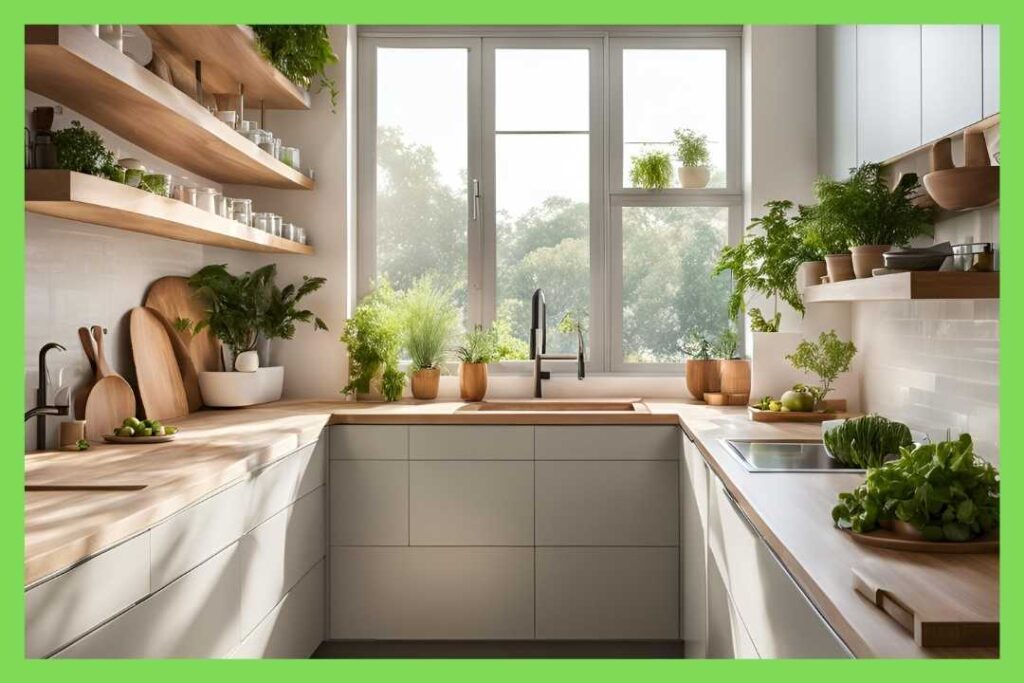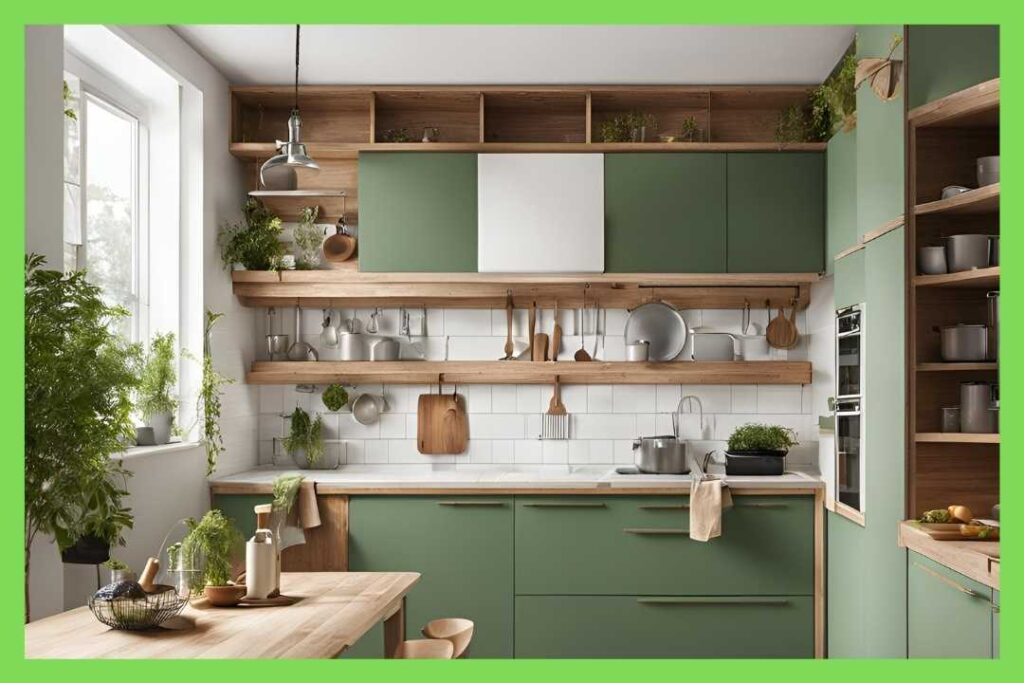Are you ready to make your kitchen eco-friendly? With growing awareness of the environment, it’s time to change how we design kitchens. What if building a reusable kitchen was easier than you thought?
This guide will show you how to make a kitchen that’s good for the planet. We’ll cover choosing the right materials, using energy-saving systems, and more. You’ll learn how to make your kitchen a green space.
Starting a sustainable kitchen journey is exciting. We’ll share tips on creating a kitchen that’s good for you and the planet. Get ready to embrace green living and help create a better future.
Embracing the Future of Sustainable Living

More people are now focusing on eco-friendly kitchens and sustainable kitchen construction. This shift is driven by growing environmental awareness. In today’s world, kitchens that can be reused are key to living green.
Why Reusable Kitchens Matter in the Age of Environmental Consciousness
Reusable kitchens help cut down on waste and lower the carbon footprint of kitchen projects. They align with the circular economy idea. This means materials keep getting used and reused, making kitchens both beautiful and eco-friendly.
Designing kitchens for reuse means using materials that can be recycled, last long, and be easily changed or fixed. This way, kitchens can last longer and produce less waste. It’s a step towards a greener future.
Reusable kitchens also use energy-saving systems and appliances. This makes them even better for the planet. By choosing sustainable kitchen construction, we help create a greener world.
“Sustainable living is not just a trend, it’s a responsibility we all share. Reusable kitchens are a tangible step towards a more circular and eco-conscious future.”
The trend of reusable kitchens will keep growing. It’s a big step towards a more sustainable world. It encourages us all to fight climate change in our own ways.
Modular Kitchen Design: The Key to Reusability
Turning your kitchen into a green, reusable space begins with modular design. This method brings many benefits for an eco-friendly and flexible kitchen. It’s a smart choice for today’s homes.
Modular kitchens stand out because they’re flexible. Unlike old-fashioned layouts, they’re made of parts that can change. This makes it easy to update your kitchen as your needs and tastes shift.
Embracing the Power of Prefabricated Systems
Prefabricated kitchen systems are key for a reusable kitchen. These pre-made parts cut down on waste and make setup quick. They’re built with recyclable kitchen materials for easy future use.
- Modular design allows for easy reconfiguration and repurposing of kitchen components
- Prefabricated systems reduce construction waste and simplify installation
- Use of recyclable kitchen materials ensures a truly sustainable solution
Modular design and prefabricated systems create a kitchen that grows with you. They meet the need for modular kitchen design and eco-friendly living.
“Modular kitchen design is the future of sustainable, reusable living. It’s a game-changer for homeowners who want to create a kitchen that can evolve with their needs and the environment.”
Choosing modular design and prefabricated systems is a big step towards a greener kitchen. It shows a commitment to prefabricated kitchen systems and the planet.
Reusable Kitchen Building: A Step-by-Step Guide

Building a reusable kitchen is a smart way to live sustainably. Choose eco-friendly and recyclable materials. Also, use energy-efficient systems and appliances. This way, your kitchen will meet your needs now and in the future.
Selecting Eco-Friendly and Recyclable Materials
When starting your reusable kitchen building project, focus on green materials. These can be easily reused or recycled. Here are some good choices:
- Choose recyclable kitchen materials like metal, glass, and sustainable wood. They can be taken apart and reused later.
- Look into renewable and biodegradable options like bamboo, cork, and recycled plastics. They help lessen your environmental footprint.
- Go for durable, long-lasting materials. They last longer and need less frequent replacement.
Implementing Energy-Efficient Systems and Appliances
Adding energy-efficient kitchen designs is key to a sustainable kitchen. Here are some tips:
- Put in high-efficiency appliances that use less energy and water. This cuts down on your bills and use.
- Use smart home tech like programmable thermostats and motion-activated lights. They help save energy and cut waste.
- Think about using renewable energy like solar panels or geothermal systems. They power your kitchen and reduce reliance on fossil fuels.
By taking these steps, you can build a reusable kitchen that’s good for you and the planet. Every eco-friendly choice you make helps the environment and saves money in the long run.
Prefabricated Kitchen Systems: The Sustainable Solution

Prefabricated kitchen systems are changing the game in eco-friendly kitchen design. They offer a sustainable option compared to traditional building methods. These systems are perfect for those looking for low-impact, circular economy kitchens.
Benefits of Off-Site Construction and Reduced Waste
The prefabricated method makes kitchen building more efficient. It involves assembling parts off-site, which cuts down on waste and environmental impact. This approach also promotes the use of circular economy principles, where materials are reused.
These kitchens are built to be modular, making it easy to change them up. This means they can grow or change with your needs. It’s a big win for sustainability in the long run.
FAQ
What are the key benefits of building a reusable kitchen?
A reusable kitchen helps the environment by reducing waste. It also makes it easy to change and update the kitchen. This approach follows the circular economy, where parts can be reused and recycled.
How does modular kitchen design support reusability?
Modular design is key for a reusable kitchen. It lets you easily change and update the kitchen. Prefabricated systems also help by cutting down on waste and making construction more efficient.
What are the essential eco-friendly and recyclable materials for a reusable kitchen?
Choose materials like sustainable wood, metal, and glass for a reusable kitchen. Stay away from plastics that are hard to recycle. This way, your kitchen can be broken down and reused or repurposed.
How can I integrate energy-efficient systems and appliances into a reusable kitchen?
For a green kitchen, pick energy-saving appliances and smart tech. Look for ENERGY STAR labels and LED lights. Adding solar panels can also boost your kitchen’s energy efficiency.
What are the benefits of using prefabricated kitchen systems for a reusable kitchen?
Prefabricated systems are great for a reusable kitchen. They cut down on waste and make construction faster. This approach also supports the kitchen’s ability to be changed and reused in the future.
